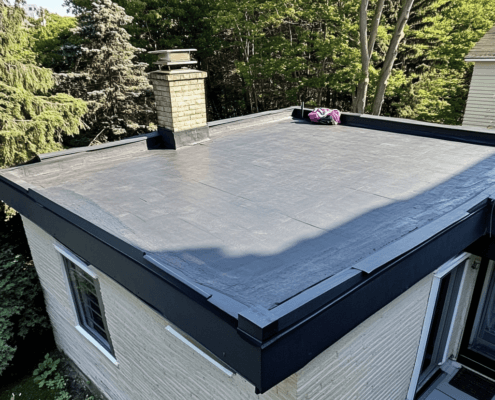The Ultimate Guide to Flat Roof Replacement: Costs, Process, and Tips
A flat roof replacement is a big decision, whether you own a home or a business. If your flat roof is old, damaged, or leaking, it might be time to replace it. This guide will explain what flat roofs are, why you might need to replace yours, and how the replacement process works. It will also help you understand the costs, materials, and tips for making the best decision when replacing your flat roof.
What Is a Flat Roof?
A flat roof is a type of roof that is almost level, or very slightly sloped. Unlike traditional pitched roofs that have steep slopes, flat roofs are nearly horizontal. Flat roofs are commonly used on commercial buildings, but they are also found on residential homes, especially in modern or urban designs.
One of the biggest advantages of a flat roof is that it creates extra usable space. You can install things like air conditioning units, solar panels, or even a rooftop garden. Flat roofs are also easier to maintain and cost less to install than pitched roofs. However, because they are flat, water doesn’t run off easily and can pool on the roof, which may lead to leaks and other problems.

Contractors carefully installing a new flat roof on a commercial property, using high-quality materials to ensure durability and protection.
Why Do You Need a Flat Roof Replacement?
There are many reasons why you might need a flat roof replacement. Over time, flat roofs can wear out and become damaged. Below are some common reasons why people replace their flat roofs:
- Old Age: Every roof has a lifespan. Most flat roofs last between 15 and 30 years, depending on the material used. If your flat roof is close to this age, it may be time to replace it.
- Leaks: Leaks are one of the most common problems with flat roofs. If you see water spots on your ceiling or walls, it’s a sign that water is getting through the roof. If leaks keep happening, replacing the roof may be the only solution.
- Weather Damage: Harsh weather like heavy rain, snow, or hail can damage a flat roof. If your roof has been through a big storm or has cracks and holes from extreme weather, it might need to be replaced.
- Poor Drainage: Flat roofs need a good drainage system to prevent water from building up. If water pools on the roof, it can cause damage over time. Clogged drains or blocked gutters can also lead to water buildup, which can lead to leaks.
- Outdated Appearance: Sometimes, people replace their flat roofs just to update the look of their home or building. If you want a more modern style or need to make changes to your roof for other reasons, a flat roof replacement might be the right choice.
Signs That You Need a Flat Roof Replacement
It’s not always easy to know when it’s time to replace your flat roof. However, there are a few signs that indicate you may need a new roof:
- Visible Damage: If you see cracks, tears, or holes in your flat roof, it’s a sign that the roof is no longer in good shape. The material on your roof may have started to break down from age or weather.
- Water Leaks: If you notice water stains on your ceiling or walls inside your home or building, there’s a good chance your roof is leaking. Small leaks can get bigger over time and cause serious damage.
- Pooling Water: Flat roofs need to have a slight slope to allow water to run off. If water stays on your roof after it rains, it can cause damage to the roof material and lead to leaks. This is called ponding, and it’s one of the main reasons for needing a flat roof replacement.
- Sagging Roof: If parts of your flat roof look like they are sagging or dipping, it may mean there’s a structural problem. A sagging roof can cause even bigger issues if not fixed right away.
- Mold or Mildew: If you notice mold or mildew on your walls or ceiling, it could be because of trapped moisture in your roof. Mold can grow if water is getting through cracks in the roof, and it may be a sign that your roof needs to be replaced.
The Process of Flat Roof Replacement
Replacing a flat roof is a job that requires professional help. It’s not something most homeowners can do by themselves, because it involves removing old materials, repairing any damage, and installing new roofing. Here is a basic overview of the flat roof replacement process:
1. Inspection and Assessment
The first step in any roof replacement is to have the roof inspected by a professional roofing contractor. They will check for any visible damage and assess the condition of the roof. They may also check the insulation and structure of the roof to make sure everything is in good condition.
2. Removing the Old Roof
Once the inspection is complete, the old roof needs to be removed. This can involve taking off the old roofing material, such as roofing membranes, shingles, or metal sheets. The roofing contractor will also remove any damaged insulation or decking.
3. Repairing the Roof Deck
If the structure underneath the roof, called the roof deck, is damaged, it will need to be repaired or replaced. The contractor will replace any rotted wood or weakened areas to ensure the new roof is properly supported.
4. Installing the New Roof
After the deck is prepared, the new roof can be installed. There are several different materials that can be used for a flat roof replacement, such as:
- EPDM (Ethylene Propylene Diene Monomer): This is a type of rubber roofing that is durable, weather-resistant, and easy to install.
- TPO (Thermoplastic Olefin): A lightweight, energy-efficient roofing material that reflects sunlight and helps reduce cooling costs.
- Modified Bitumen: A type of asphalt roofing that is tough and ideal for cold or hot climates.
- PVC (Polyvinyl Chloride): A strong, fire-resistant roofing material often used on commercial buildings.
5. Adding the Finishing Touches
Once the new roofing material is installed, the contractor will add finishing touches like sealants, flashing around edges, and a coating to protect the roof from UV rays. The contractor will also ensure that the drainage system is functioning properly to prevent future water pooling.
6. Final Inspection and Clean-Up
After the installation is complete, the contractor will do a final inspection to make sure everything is properly installed and sealed. They will also clean up any debris left from the old roof and ensure the site is safe and clean.
Costs of Flat Roof Replacement
The cost of a flat roof replacement can vary based on several factors, including the size of your roof, the materials you choose, and the complexity of the job. On average, homeowners can expect to pay anywhere from $3,000 to $10,000 for a flat roof replacement. For commercial buildings, the cost may be higher, depending on the size of the roof and the materials used.
Here are some factors that can affect the cost of replacing your flat roof:
- Roof size: Larger roofs will cost more to replace because they require more materials and labor.
- Material choice: Some materials, like EPDM or PVC, may cost more than others, such as TPO or modified bitumen.
- Roof condition: If your roof has significant damage or needs extra repairs to the roof deck, this will add to the overall cost.
- Labor: Roofing contractors charge for their time and expertise. The more complex the roof, the more labor will be required.
Tips for Flat Roof Replacement
Here are a few tips to help you during the flat roof replacement process:
- Hire a Reputable Contractor: Make sure to hire a qualified and experienced roofing contractor. Ask for references, check their reviews, and make sure they are licensed and insured.
- Get Multiple Estimates: Don’t settle for the first estimate you receive. Get quotes from at least three contractors to ensure you’re getting a fair price.
- Consider Energy-Efficient Materials: Look into roofing materials that reflect sunlight and help keep your home or building cool, which can reduce energy costs in the long run.
- Check for Warranties: Be sure to ask about warranties for the roofing materials and the installation work. A good warranty will give you peace of mind that the roof will be protected for years to come.
Wrapping Up Your Flat Roof Replacement Journey
A flat roof replacement is a significant investment, but it’s also a crucial step in maintaining the safety and longevity of your property. Whether you’re replacing an old roof, addressing leaks, or upgrading to more energy-efficient materials, understanding the process, materials, and costs involved will help you make informed decisions.
By hiring a qualified and experienced roofing contractor, you can ensure that your flat roof replacement is done correctly, with quality materials and attention to detail. A well-installed flat roof can last for many years, protecting your home or business from the elements and adding value to your property.
Taking the time to ask the right questions, plan your project carefully, and choose the best materials will help you get the best results, no matter what kind of flat roof you need to replace.







